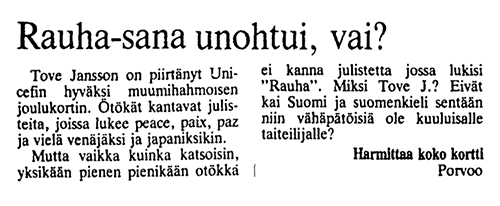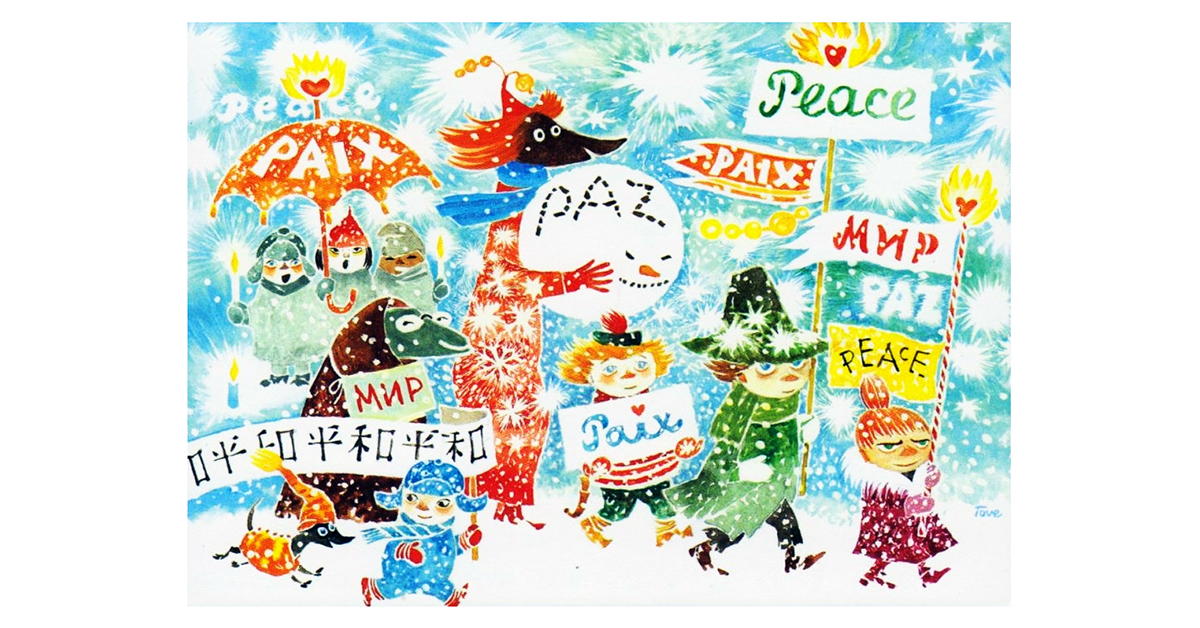During her extensive career, Tove Jansson also illustrated postcards for charity. In 1971, UNICEF’s Christmas card assortment included the card ‘Wonder of Christmas’, and ten years later ‘March for Peace’. The March for Peace card has become a much-loved iconic item, but was not initially loved by all – we dive into this rather entertaining debate.
On December 24th, 1981 Finland’s largest newspaper Helsingin Sanomat published an opinion piece about the ‘March for peace’ card. The commenter was upset that the Finnish word for peace, ‘rauha’, was missing among the five languages represented on the card.
The angry reader signed the opinion piece with the signature “Annoyed by the entire card” and wondered whether Finland and the Finnish language were too insignificant for the famous artist.

Tove Jansson used to answer all letters received from fans personally, and although this feedback was published in a newspaper, Jansson found it important to answer.
She had earlier discussed the postcard draft with Birgitta Boucht, who was the editor in chief at Fredsposten, a magazine for the Finnish peace movement written in Swedish. After seeing the commentary published by Helsingin Sanomat, Jansson asked if Fredsposten could publish her response “as a curio”.

Kära Birgitta,
Minns du vi pratade om Unicefs kort, den första skissen? Apropå en arg insändare i Hels. San.
24 dec. Tror du saken kunde nämnas i Fredsposten som en kuriositet?
Tänkte svara på insändaren men det blev inte av och nu är det ju lite sent på dan.
Vad jag ville ha sagt: “‘Rauha-sana unohtui, vai? Signaturen ‘Harmittaa koko kortti, Porvoo’ är
upprörd över att jag på mitt julkort för Unicef har utelämnat ordet Rauha i det fredståg jag har
tecknat. Nu ville jag gärna tala om att på den första skissen hade jag både rauha och en massa
andra språk, det var ett helt äventyr att försöka ta reda på hur man ska säga fred på så många sätt
som möjligt. Men Unicef förklarade att i dessa sammanhang får man bara använda fem olika
språk. Förstå det, den som kan! Tove Jansson”
In her letter to Birgitta Boucht, Tove Jansson explains how in her first draft she had written the word “peace” in Finnish and in many other languages, and how finding out the translations was an adventure itself. However, for the final card, UNICEF wanted only five languages, and Finnish was among those left out.
Fredsposten magazine 2/1982 published Tove’s answer as she wished. Hopefully the worried person from Porvoo, Finland also received the answer to her/his question published in Helsingin Sanomat on Christmas Eve 1981.

Tove Jansson’s letter, dated March 7th, 1982 was recently published in the Fredsposten magazine 4/2017.
Reprinted classics
The postcard Wonder of Christmas was reprinted in 1995. The illustration is based on the picture Tove Jansson drew for the book “Tales from Moominvalley” in 1962. The illustration in the short story “The Fir Tree” is quite similar to the illustration in the UNICEF’s card but in the card for example, there is a star at the top of the tree, not a silk rose like in the book. Tove Jansson wrote: “They looked at the sky, black and distant but unbelievably full of stars, a thousand times more than in summer. And the biggest one was hanging exactly above the top of their fir tree.” This view illuminates the entire card.
In autumn 2000, UNICEF asked Tove Jansson for her permission to also reprint the card March for Peace. Tove was delighted at the request and said that she was more than happy to give permission, that she still could do something good for the kids, although she was not able to paint anymore. Artist Tove Jansson died in the summer of 2001 and in the winter 2001, UNICEF launched the new edition of the lovely card with the peace theme.
